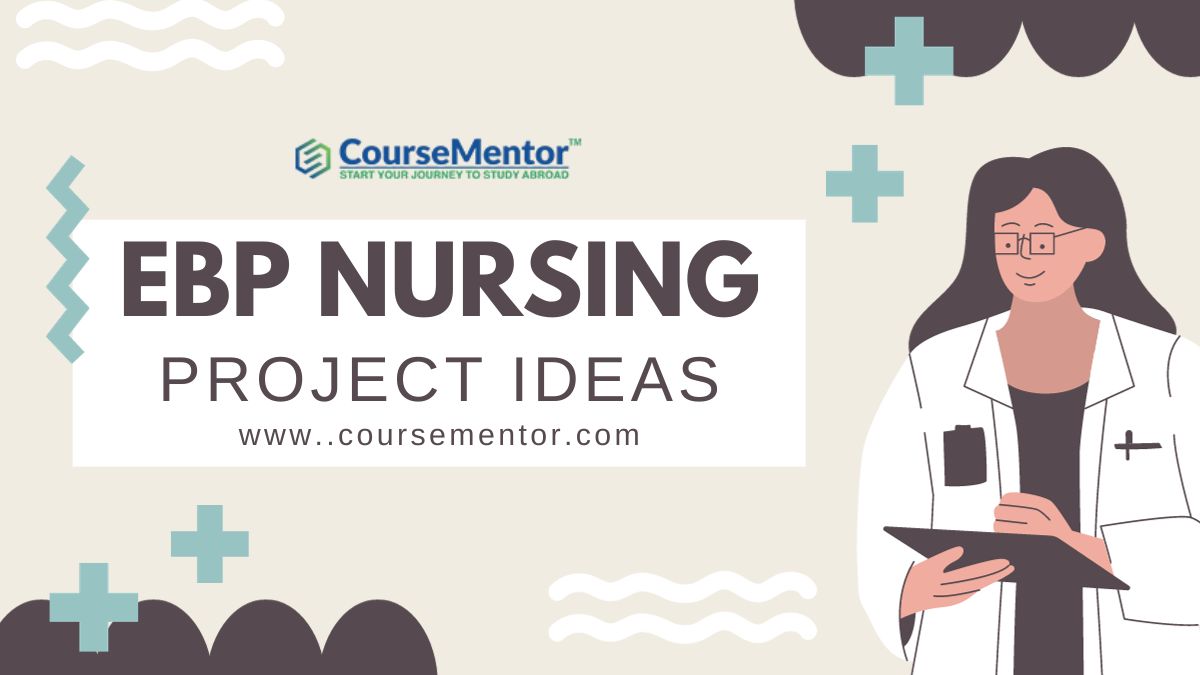Discover a world of impactful nursing projects. Explore EBP nursing project ideas that can transform healthcare and elevate your nursing practice.
In the dynamic world of healthcare, nursing professionals are the unsung heroes of patient well-being. The essence of patient care isn’t just in the textbooks; it’s in your innovative spirit and commitment to making a difference.
Evidence-Based Practice (EBP) is your canvas to paint the future of patient care, and we’ve got a palette of captivating EBP project ideas just for you.
EBP isn’t a dull chore; it’s your chance to be a healthcare magician, conjuring new ways to enhance patient care and revolutionize nursing practice.
These aren’t just projects; they’re your ticket to crafting a brighter, healthier future for your patients and your profession. So, fasten your seatbelts, and let’s explore the innovative world of EBP nursing projects!
The Power of EBP in Nursing
Check out the power of EBP in nursing:-
EBP: Unleashing Nursing Superpowers
Evidence-Based Practice (EBP) isn’t just another acronym; it’s the secret weapon in a nurse’s arsenal. It’s the art of blending cutting-edge research, real-life know-how, and patient preferences into a care superpower.
Clinical Expertise: Where the Magic Begins
Every nursing journey starts with clinical expertise, the magical blend of skills, intuition, and bedside wisdom. It’s the bedrock upon which nurses build their EBP castles.
Patient-Centered Care: Because Every Patient is the Hero
EBP champions patient values and preferences, making every patient the hero of their care story. It’s a tale of collaboration and shared decision-making, where nurses and patients write the script together.
Guided by Research: Where Science Meets the Heart
EBP dances to the rhythm of research. It’s the beat of the latest scientific evidence that keeps nurses on their toes, ensuring they deliver the best, evidence-backed care.
Reducing Variations in Practice: A Symphony of Consistency
EBP conducts a symphony of consistency, harmonizing care across different settings. It’s the sheet music that ensures everyone in the orchestra plays the same notes, leading to safer, more standardized care.
Minimizing Errors: The Safety Net We All Need
EBP is the safety net that catches potential errors before they become a high-wire act. It’s the thorough examination of practices, ensuring that every step is based on solid evidence, not guesswork.
Questioning the Status Quo: Dare to Dream, Nurse!
EBP is the captain of innovation. It urges nurses to cast a critical eye on established practices and dream of better ways. It’s the path to challenging the norm and seeking fresh solutions.
Continuous Improvement: The Never-Ending Story
EBP is the story of never-ending improvement. It’s a narrative that nurses write with each patient interaction. It’s about always asking, “How can we make this better?”
Elevating Nursing Practice : From Practice to Pinnacle
EBP transforms nursing from practice to pinnacle. It’s the elevator to excellence, lifting nurses to new heights of impact on patient outcomes and the healthcare world.
A Future of Possibilities: Where Nurses Lead the Way
EBP is the portal to endless possibilities. It’s the treasure map to improving patient care, conducting groundbreaking research, and pioneering the future of healthcare. So, grab your compass, nurse, and let’s set sail to new horizons!
The power of EBP in nursing isn’t just about care; it’s about empowerment, innovation, and the promise of a brighter, patient-centered future.
EBP Nursing Project Ideas
Check out EBP nursing project ideas:-
Patient Safety and Quality Improvement
- Reducing Medication Errors: Implement a barcode scanning system for medication administration.
- Enhancing Hand Hygiene Compliance: Develop a hand hygiene training program with gamified elements.
- Preventing Patient Falls: Introduce bed exit alarms with personalized settings to alert healthcare providers.
- Improving Pain Management: Evaluate the effectiveness of virtual reality (VR) therapy in managing pain.
- Reducing Hospital-Acquired Infections: Implement UV-C disinfection robots to reduce the risk of infection.
- Enhancing Medication Reconciliation: Develop an automated medication reconciliation process to reduce errors during transitions of care.
- Enhancing Pressure Ulcer Prevention: Implement pressure redistribution mattresses and conduct skin assessment protocols.
- Promoting Safe Patient Handling: Introduce mechanical lift devices to reduce manual patient handling injuries.
- Improving Emergency Response: Implement Rapid Response Teams (RRT) for early detection of deteriorating patients.
- Enhancing Patient Discharge Planning: Introduce a standardized discharge planning process to ensure patients receive appropriate post-discharge care.
Patient Education and Engagement
- Patient-Centered Education Materials: Develop customized patient education materials based on individual patient needs.
- Promoting Medication Adherence: Create a medication adherence program that includes reminders and educational resources.
- Supporting Diabetes Management: Establish diabetes self-management classes with ongoing support for patients.
- Nutrition and Wellness Workshops: Organize regular workshops on healthy nutrition and wellness practices.
- Maternity and Newborn Education: Develop comprehensive education programs for expectant mothers and newborn care.
- Smoking Cessation Programs: Offer smoking cessation programs and counseling for patients seeking to quit smoking.
- Weight Management Initiatives: Create a weight management program with nutritionists and exercise specialists.
- Geriatric Health Seminars: Host health seminars tailored to the unique needs of elderly patients.
- Childhood Obesity Prevention: Implement school-based programs to promote healthy lifestyles for children.
- Mental Health Education: Develop educational resources and support groups for patients dealing with mental health challenges.
Workplace and Staffing Optimization
- Nurse-Patient Ratio Adjustments: Evaluate the impact of adjusting nurse-patient ratios on patient outcomes.
- Predictive Analytics for Staffing: Utilize data analytics to predict staffing needs based on patient acuity.
- Nurse-Physician Communication Improvement: Implement interprofessional communication training to enhance teamwork and patient care.
- Staff Resilience Training: Offer resilience training programs to support staff well-being and reduce burnout.
- Cultural Competency Training: Provide cultural competency training to enhance the delivery of culturally sensitive care.
- Patient-Centered Rounding: Implement structured patient-centered rounding for improved patient communication.
- Nurse Mentorship Programs: Develop mentorship programs to support the professional growth of novice nurses.
- Flexible Scheduling Options: Introduce flexible scheduling options to improve staff satisfaction and work-life balance.
- Advanced Technology Integration: Implement innovative healthcare technologies like telemedicine and AI-based tools.
- Patient and Family Advisory Councils: Engage patients and their families in advisory councils to provide input on healthcare delivery.
Technology and Telehealth
- Telehealth for Chronic Disease Management: Implement telehealth services for patients with chronic diseases.
- Remote Patient Monitoring: Use wearable devices to remotely monitor vital signs and disease parameters.
- Telemedicine Consultations: Offer telemedicine consultations for patients seeking medical advice.
- Mobile Health Applications: Develop a mobile app for patients to access health information and monitor their health.
- EHR Optimization: Enhance the use of electronic health records (EHRs) to improve information sharing and patient care.
- Telepsychiatry Services: Provide telepsychiatry services for mental health support.
- Tele-Rehabilitation Programs: Conduct rehabilitation sessions via telehealth for patients with mobility issues.
- Tele-Nursing Education: Offer nursing education through teleconferencing to reach a wider audience.
- Remote Specialty Consultations: Facilitate remote consultations with specialty physicians.
- Telehealth for Postoperative Care: Use telehealth for postoperative follow-up and wound assessments.
Readmission Reduction
- Enhanced Discharge Planning: Develop a comprehensive discharge planning process with patient and caregiver involvement.
- Post-Discharge Follow-up Calls: Implement a system for making post-discharge follow-up calls to monitor patient progress.
- Transitional Care Programs: Establish transitional care programs that bridge the gap between hospital and home care.
- Home Health Services: Offer home health services to provide necessary care to patients in their own homes.
- Medication Management Support: Provide medication management support for patients during the transition from hospital to home.
- Care Coordination Teams: Create care coordination teams to ensure a seamless transition for patients.
- Telehealth for Postoperative Monitoring: Use telehealth for postoperative monitoring, reducing the need for readmission.
- Patient and Caregiver Education: Offer education to patients and caregivers to ensure they can manage post-discharge care effectively.
- Improved Communication with Primary Care Providers: Strengthen communication and information sharing with patients’ primary care providers.
- Patient-Centered Discharge Summaries: Develop patient-centered discharge summaries that are easy to understand and follow.
Innovations in Nursing Practice
- Advanced Wound Care Techniques: Introduce advanced wound care techniques, such as negative pressure wound therapy or hyperbaric oxygen therapy.
- Pediatric Pain Management: Implement specialized pain management strategies tailored to the needs of pediatric patients.
- Geriatric Care Excellence: Develop a program to enhance the care of elderly patients, considering their unique healthcare requirements.
- Innovative Palliative Care: Create innovative palliative care programs for patients with serious illnesses.
- Patient Advocacy Initiatives: Establish patient advocacy programs to ensure that patient voices are heard and acted upon.
- Patient Navigation Services: Provide patient navigation services to guide patients through complex healthcare systems.
- Integrative Healthcare Modalities: Integrate complementary and alternative healthcare modalities into patient care.
- Cultural Competency Initiatives: Implement cultural competency initiatives to provide care that respects diverse cultural backgrounds.
- Advanced Care for Surgical Patients: Develop specialized care programs for surgical patients, focusing on their unique needs.
- Supportive Care for Oncology Patients: Offer comprehensive supportive care for cancer patients, addressing physical, emotional, and psychological needs.
These EBP nursing project ideas span various domains of healthcare, offering a rich tapestry of opportunities for nursing professionals to improve patient care and make a lasting impact in their field.
What is a good EBP nursing topics?
When it comes to diving into the world of Evidence-Based Practice (EBP) nursing research, choosing the right topic is your compass.
It’s not just about ticking boxes; it’s about finding a topic that truly resonates with you. So, what makes a great EBP nursing topic? Here’s the lowdown:
Preventing Grand Tumbles
How about unraveling the mystery of keeping our beloved seniors safe from falls? Dive into the world of interventions for preventing falls in older adults and make a real impact on their well-being.
Heartfelt Medication Adherence
If you’re a heart enthusiast, exploring the impact of nurse-led education on medication adherence in heart failure patients could be your calling. It’s like helping hearts beat stronger!
Cracking the Pain Management Code
Pain matters. Research different pain management strategies and see how they affect patient satisfaction and overall well-being. You might just become the go-to pain guru.
Healing Diabetic Foot Woes
Diabetic foot ulcers are a challenging adversary, but you can be the hero. Investigate which wound care dressings work best to promote healing and give patients a spring in their step.
Telehealth for COPD Champions
Embrace technology and explore the impact of nurse-led telehealth programs on COPD patients. You’re not just a nurse; you’re a digital healthcare pioneer.
Breastfeeding Support Superstar
If maternal and child health is your passion, check out the effects of various breastfeeding support interventions. It’s like being a guardian angel for new moms and their bundles of joy.
Defeating UTI Monsters
Ready to tackle catheter-associated urinary tract infections (CAUTIs)? Research the most effective strategies to prevent them and become the defender of patient comfort.
Sepsis Savior
Sepsis is a formidable foe, but a nurse-led intervention can make a world of difference. Explore the impact on patient satisfaction and outcomes, and you could be a lifesaver.
Pressure Ulcer Prevention Pro
No one wants pressure ulcers. Research different nursing care interventions to prevent them and become the champion of patient comfort.
Burnout Buster
Nursing isn’t just a profession; it’s a calling. Find out how to reduce stress and burnout in the nursing community. You could be the spark that keeps the flame burning brightly.
Cancer Compassion
Stand by cancer patients as you research the impact of nurse-led programs on patient satisfaction and outcomes. Your care can be the ray of hope they need.
Childhood Comfort Creator
Kids need special care. Investigate different interventions for pain management in children and make healthcare less scary for them.
Golden Years Vitality
Promoting physical activity in older adults is like sprinkling the fountain of youth. Explore various strategies and help seniors live their best lives.
These topics aren’t just research ideas; they’re potential adventures that align with your passions and expertise.
If you’re ever in doubt, chat with a wise nurse educator or a seasoned colleague—they’ll help you find the perfect EBP nursing topic that sets your soul on fire.
Remember, it’s not just a topic; it’s your chance to make a real impact on patient care, one passion-driven project at a time.
What is a good nursing capstone project?
Selecting the perfect nursing capstone project is akin to discovering a hidden gem that’s not only relevant to your nursing practice but also exudes clinical significance.
It should be a topic that fuels your passion and, most importantly, holds the potential to leave a positive mark on the nursing profession. Here’s a glimpse of some inspiring nursing capstone project ideas:
Educational Empowerment
Craft a cutting-edge educational program tailored for nurses, focusing on specific topics such as pain management or wound care. Share knowledge that lights the way for fellow nurses.
Quality Improvement Pioneer
Become a quality improvement trailblazer by initiating a novel improvement project within your nursing unit or hospital. Transform the care you provide into a benchmark for excellence.
Innovative Nursing Interventions
Evaluate the effectiveness of new nursing interventions or technologies, unlocking the potential to redefine patient care practices.
Exploring New Horizons
Venture into uncharted nursing territory, be it telehealth or palliative care. Expand your nursing expertise and bring innovation to the forefront.
Policy for Enhanced Care
Develop a groundbreaking policy or procedure that enhances the safety and quality of nursing care, raising the standard for healthcare.
Ethical Dilemma Resolver
Tackle nursing-related ethical dilemmas, from informed consent to end-of-life care, and be the voice for ethical integrity in healthcare.
Social and Environmental Nexus
Investigate how social and environmental factors, like poverty or climate change, impact health, shedding light on critical issues that affect us all.
Research Revolution
Embark on a journey of discovery by developing a new research protocol that unravels previously unexplored nursing phenomena.
These are just a few rays of inspiration, and the world of nursing capstone projects brims with numerous other enticing ideas.
As you embark on this quest, remember to consult with your faculty advisor to ensure your chosen topic aligns with your goals and the academic requirements.
Once you’ve chosen your topic, it’s time to craft your capstone project proposal. This proposal is your roadmap, outlining your research question, methodology, expected outcomes, resource requirements, and a timeline for completion. It’s your declaration of commitment to advancing nursing knowledge.
Nursing capstone projects, though challenging, are immensely rewarding. They are your canvas to showcase your expertise, skills, and unwavering dedication to the nursing profession.
By the journey’s end, you won’t just be a nurse; you’ll be a transformative force within the healthcare world, leaving a legacy of excellence.
What are EBP projects?
Evidence-based practice (EBP) projects are like thrilling adventures through the world of nursing. These quests are designed to unlock the secrets of effective nursing interventions and practices.
Ultimately raising the bar for the quality of nursing care and patient well-being. Join us on this exciting journey as we navigate the essential steps of EBP projects:
Discovering the Nursing Enigma
Your quest begins with identifying a clinical challenge or a golden opportunity for improvement within nursing practice. It’s like setting out on a treasure hunt, scouring the literature, conversing with patients and their families, or closely observing nursing practices for clues.
Forging the Research Question
As you uncover your quest’s mission, the next step is to craft a research question. This question is your guiding compass, leading you with its SMART attributes—Specific, Measurable, Achievable, Relevant, and Time-bound.
Hunting for Knowledge Artifacts
With your mission in hand, it’s time to embark on a quest for knowledge. You’ll venture into databases, use search engines, and explore various resources to gather the wealth of information needed for your adventure.
Evaluating the Evidence
Like a seasoned detective, you’ll critically appraise the evidence gathered to separate the gems from the pebbles. You’re on a quest for quality and relevance, ensuring that your findings are the brightest stars in the night sky.
Weaving the Tapestry of Knowledge
Your journey continues by weaving together the evidence to create a compelling narrative. It’s the puzzle of the EBP world, and as you piece it together, a clear picture of implications for nursing practice emerges.
The Real-World Transformation
The climax of your quest is the application of evidence in the real world of nursing practice. This is where the magic unfolds; it could involve creating new interventions, refining existing practices, or even revolutionizing how nursing care is delivered.
EBP projects are not solo endeavors; they can be led by individuals, courageous nursing teams, or dedicated researchers.
Whether your quest is small or grand, it can unfold in diverse healthcare settings, from bustling hospitals to serene community health centers.
As you embark on your EBP adventure, remember you’re the hero of the story, the explorer of the unknown, and the guardian of nursing excellence.
Your journey has the power to transform healthcare, one evidence-based step at a time. So, don your armor, unsheathe your sword of knowledge, and step boldly into the world of EBP. Your quest awaits!
What is an example of an EBP question in nursing?
In the realm of nursing, an example of an Evidence-Based Practice (EBP) question might be:
“What’s the most effective way to prevent falls in older adults within a hospital setting?”
This question isn’t just a mere query; it’s a powerful beacon, guiding us on a journey that’s Specific, Measurable, Achievable, Relevant, and Time-bound (SMART).
It’s a question that resonates with clinical significance, for falls are a major concern, particularly among older adults in hospital settings.
To unravel this question, a nurse embarks on a quest through the corridors of knowledge:
The Quest for Evidence
The journey commences with a thorough literature search, a quest for the wisdom hidden within the pages of research. It’s like an archeological expedition, excavating treasures that could transform nursing practice.
Evaluating the Findings
With evidence in hand, the nurse becomes a detective, meticulously appraising the quality and relevance of each piece of the puzzle. This step separates the gems from the pebbles.
Weaving the Tapestry
Like an artisan weaving a masterpiece, the nurse synthesizes the evidence, connecting the dots to reveal a comprehensive narrative. It’s a process that unveils the implications for nursing practice.
The Transformation
The final act of this quest is the application of evidence in nursing practice. It’s where the nurse becomes a maestro, composing new fall prevention interventions or orchestrating changes to existing ones.
This EBP question isn’t just a curiosity; it’s a quest for excellence, a call to action. It’s a journey that can impact the lives of older adults in hospital settings, enhancing their safety and well-being.
So, when we pose such questions in nursing, we embark on a noble quest to elevate patient care and illuminate the path to excellence.
Conclusion
As we wrap up our exhilarating journey through the world of EBP nursing project ideas, one thing becomes abundantly clear—nursing isn’t just a profession; it’s a calling, a commitment to making a profound difference in the lives of patients and their families.
Evidence-Based Practice (EBP) is the magical wand that transforms this commitment into tangible innovations and enhanced patient care.
These projects aren’t just abstract ideas; they are the sparks that ignite change, the keys to a brighter future of healthcare.
They beckon nursing professionals to step into the arena, to question norms, and to create a healthcare revolution, one project at a time.
In the realm of patient safety and quality improvement, we’ve unveiled projects that are like guardian angels, tirelessly working to reduce medication errors, prevent falls, and make the pain bearable.
They stand as sentinels of patient well-being, ensuring that each healthcare encounter is safer and more effective.
The patient education and engagement category radiates with projects that are like friendly guides, empowering patients with knowledge and support.
From personalized education materials to programs that nudge us toward healthier lifestyles, these initiatives forge stronger bonds between healthcare providers and those they care for.
Workplace and staffing optimization projects are akin to harmony conductors, orchestrating better conditions for nursing professionals and patients.
They adjust nurse-patient ratios, fine-tune communication, and promote resilience, all to create an environment where everyone thrives.
In the era of technology and telehealth, EBP projects invite us to explore the brave new world of healthcare.
Telehealth services, mobile apps, and advanced EHR systems are the instruments through which nursing professionals compose a symphony of healthcare that’s more accessible and personalized.
Readmission reduction projects are our allies in ensuring that patients’ journeys continue smoothly even after they leave the hospital. Enhanced discharge planning, follow-up calls, and transitional care programs extend the circle of care beyond the hospital walls.
At the forefront of our journey are innovations in nursing practice, where the spotlight is on specialized care, advanced wound management, and patient advocacy.
These projects embody the ever-evolving nature of nursing, a profession that constantly seeks growth and excellence.
As nursing professionals embark on their EBP journey, they wield the power to reshape patient care, improve practices, and enrich the healthcare experience. The future of nursing isn’t just a vision; it’s a reality, sculpted with every EBP project undertaken.
So, as you embark on your mission to enhance patient care, remember that the path to transformation begins with a single idea, one project that can change the game.
Nursing isn’t just a profession; it’s a calling to be a healthcare superhero, and these projects are your cape.
Together, they compose the epic tale of a future where patient care is better, lives are healthier, and the healthcare system is a constant evolution. Embrace it, nurse, and let your EBP projects be the hero of the story.
Frequently Asked Questions
What is the first step in starting an EBP project in nursing?
The first step is to identify a specific issue or problem in your clinical practice that can benefit from evidence-based interventions. This forms the foundation of your EBP project.
How can I ensure my EBP project is unique and innovative?
To make your EBP project stand out, stay updated on the latest research and innovations in healthcare. Consider collaboration with colleagues and mentors for fresh ideas.
Are there resources available to help with EBP project development?
Yes, many resources, including EBP guidelines, research databases, and support from experienced mentors, can aid in the development and execution of your EBP project.
How can I measure the success of my EBP project?
The success of your project can be measured by tracking relevant outcomes, such as improved patient safety, reduced medication errors, or increased patient satisfaction. Define clear metrics for success at the project’s outset.
Can I publish the results of my EBP project?
Yes, sharing your EBP project findings through research publications or presentations at healthcare conferences is a great way to contribute to the field and highlight your innovations.





